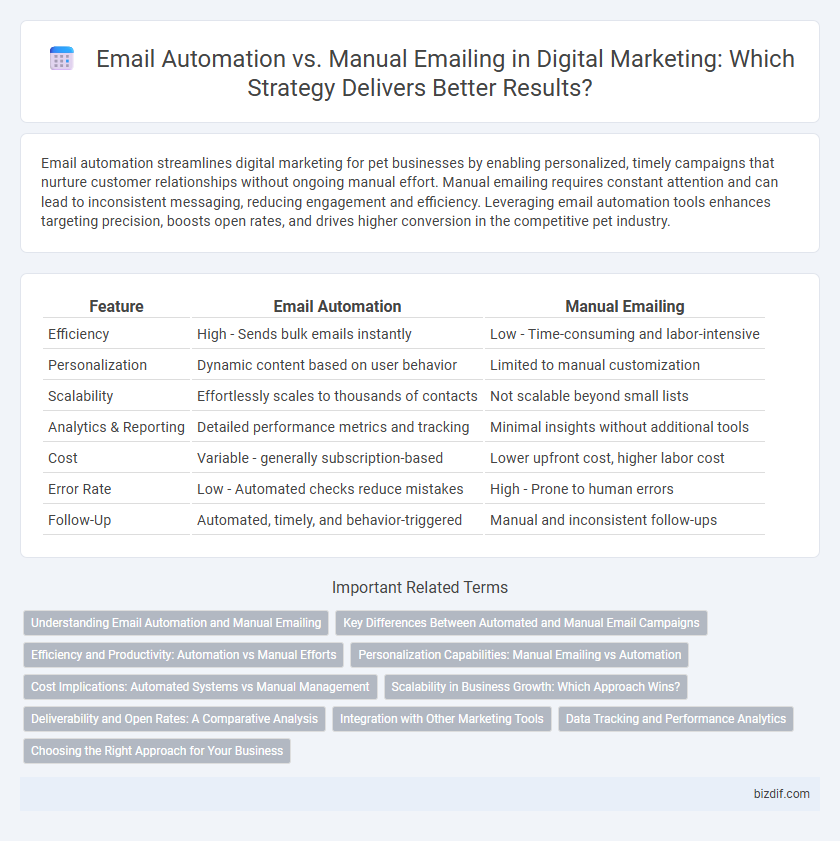Email automation streamlines digital marketing for pet businesses by enabling personalized, timely campaigns that nurture customer relationships without ongoing manual effort. Manual emailing requires constant attention and can lead to inconsistent messaging, reducing engagement and efficiency. Leveraging email automation tools enhances targeting precision, boosts open rates, and drives higher conversion in the competitive pet industry.
Table of Comparison
| Feature | Email Automation | Manual Emailing |
|---|---|---|
| Efficiency | High - Sends bulk emails instantly | Low - Time-consuming and labor-intensive |
| Personalization | Dynamic content based on user behavior | Limited to manual customization |
| Scalability | Effortlessly scales to thousands of contacts | Not scalable beyond small lists |
| Analytics & Reporting | Detailed performance metrics and tracking | Minimal insights without additional tools |
| Cost | Variable - generally subscription-based | Lower upfront cost, higher labor cost |
| Error Rate | Low - Automated checks reduce mistakes | High - Prone to human errors |
| Follow-Up | Automated, timely, and behavior-triggered | Manual and inconsistent follow-ups |
Understanding Email Automation and Manual Emailing
Email automation leverages software to send personalized messages at scale based on user behavior, improving efficiency and engagement rates. Manual emailing requires individual crafting and sending of emails, offering customization but limiting scalability and time management. Understanding these differences helps businesses optimize communication strategies for higher conversion and customer retention.
Key Differences Between Automated and Manual Email Campaigns
Automated email campaigns use predefined triggers and workflows to send personalized messages at optimal times, increasing efficiency and engagement rates compared to manual emailing, which requires individual message creation and scheduling. Key differences lie in scalability, as automation handles large volumes without additional resources, whereas manual emailing is time-consuming and prone to human error. Data-driven insights from automation enable real-time optimization, while manual campaigns often lack immediate performance tracking and consistent follow-up.
Efficiency and Productivity: Automation vs Manual Efforts
Email automation significantly boosts efficiency and productivity by enabling personalized campaigns to be sent at scale with minimal human intervention, reducing the time spent on repetitive tasks. In contrast, manual emailing requires considerable effort to craft, segment, and send messages individually, leading to slower campaign execution and higher chances of errors. Leveraging automation tools enhances workflow consistency, accelerates response times, and frees marketing teams to focus on strategy and creative optimization.
Personalization Capabilities: Manual Emailing vs Automation
Manual emailing allows marketers to tailor messages with unique insights and nuanced personalization based on direct customer interactions, but it is time-consuming and limits scalability. Email automation leverages dynamic content and behavioral triggers to deliver personalized messages at scale, improving efficiency and targeting accuracy. Combining automation with strategic manual adjustments can enhance overall personalization capabilities and customer engagement.
Cost Implications: Automated Systems vs Manual Management
Email automation significantly reduces labor costs by eliminating repetitive tasks and allowing scalable campaign management, whereas manual emailing demands extensive time and human resources, increasing operational expenses. Automated systems often incur upfront and subscription fees but deliver higher ROI through efficiency and precision targeting, contrasting with manual emailing's unpredictable costs tied to workforce allocation and error management. Businesses leveraging email automation benefit from streamlined workflows and consistent audience engagement without proportional rises in expenditure characteristic of manual approaches.
Scalability in Business Growth: Which Approach Wins?
Email automation significantly enhances scalability in business growth by enabling personalized, timely campaigns to reach thousands of customers simultaneously, reducing human error and saving time. In contrast, manual emailing limits scalability due to its time-consuming nature and higher risk of inconsistency, making it challenging to sustain large-scale outreach efficiently. Businesses aiming for rapid expansion benefit from automation tools that streamline communication, increase engagement rates, and provide valuable analytics for continuous optimization.
Deliverability and Open Rates: A Comparative Analysis
Email automation significantly enhances deliverability by optimizing send times based on recipient behavior and employing adaptive authentication protocols, resulting in higher inbox placement compared to manual emailing. Automated campaigns leverage segmentation and personalization algorithms that increase open rates by tailoring content to individual preferences, whereas manual emails often suffer from generic messaging and inconsistent timing. Data indicates automated emails achieve up to 70% higher open rates and 20% better deliverability metrics than manually sent messages, making automation a critical tool for maximizing email marketing effectiveness.
Integration with Other Marketing Tools
Email automation seamlessly integrates with CRM systems, social media platforms, and analytics tools, enabling marketers to create synchronized campaigns and track performance in real-time. Manual emailing often lacks this level of integration, leading to fragmented data and inefficiencies in targeting and personalization. Automated workflows enhance lead nurturing and customer segmentation by connecting various marketing channels into a cohesive ecosystem.
Data Tracking and Performance Analytics
Email automation significantly enhances data tracking and performance analytics by enabling real-time monitoring of open rates, click-through rates, and conversion metrics through integrated analytics platforms. Manual emailing lacks the scalability and precision of automated systems, resulting in limited data accuracy and delayed insights. Leveraging automation tools allows marketers to optimize campaigns efficiently based on detailed performance data and user behavior analysis.
Choosing the Right Approach for Your Business
Email automation enhances efficiency by sending personalized, timely campaigns triggered by user behavior, increasing engagement and conversion rates. Manual emailing offers flexibility for small-scale, highly customized communication but is time-consuming and less scalable. Businesses aiming for growth and consistent outreach benefit more from automated systems, while niche or low-volume operations may prefer manual methods for precision.
Email automation vs Manual emailing Infographic

 bizdif.com
bizdif.com